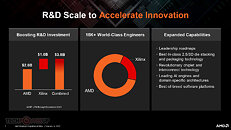- Joined
- Oct 9, 2007
- Messages
- 47,785 (7.40/day)
- Location
- Dublin, Ireland
| System Name | RBMK-1000 |
|---|---|
| Processor | AMD Ryzen 7 5700G |
| Motherboard | Gigabyte B550 AORUS Elite V2 |
| Cooling | DeepCool Gammax L240 V2 |
| Memory | 2x 16GB DDR4-3200 |
| Video Card(s) | Galax RTX 4070 Ti EX |
| Storage | Samsung 990 1TB |
| Display(s) | BenQ 1440p 60 Hz 27-inch |
| Case | Corsair Carbide 100R |
| Audio Device(s) | ASUS SupremeFX S1220A |
| Power Supply | Cooler Master MWE Gold 650W |
| Mouse | ASUS ROG Strix Impact |
| Keyboard | Gamdias Hermes E2 |
| Software | Windows 11 Pro |
AMD (NASDAQ: AMD) today announced the completion of its acquisition of Xilinx in an all-stock transaction. The acquisition, originally announced on October 27, 2020, creates the industry's high-performance and adaptive computing leader with significantly expanded scale and the strongest portfolio of leadership computing, graphics and adaptive SoC products. AMD expects the acquisition to be accretive to non-GAAP margins, non-GAAP EPS and free cash flow generation in the first year.
"The acquisition of Xilinx brings together a highly complementary set of products, customers and markets combined with differentiated IP and world-class talent to create the industry's high-performance and adaptive computing leader," said AMD President and CEO Dr. Lisa Su. "Xilinx offers industry-leading FPGAs, adaptive SoCs, AI engines and software expertise that enable AMD to offer the strongest portfolio of high-performance and adaptive computing solutions in the industry and capture a larger share of the approximately $135 billion market opportunity we see across cloud, edge and intelligent devices."



Former Xilinx CEO Victor Peng will join AMD as president of the newly formed Adaptive and Embedded Computing Group (AECG). AECG remains focused on driving leadership FPGA, Adaptive SoC and software roadmaps, now with the additional scale of the combined company and the ability to offer an expanded set of solutions including AMD CPUs and GPUs.
"The rapid expansion of connected devices and data-intensive applications with embedded AI are driving the growing demand for highly efficient and adaptive high-performance computing solutions," said Victor Peng. "Bringing AMD and Xilinx together will accelerate our ability to define this new era of computing by providing the most comprehensive portfolio of adaptive computing platforms capable of powering a wide range of intelligent applications."
Upon close, Xilinx stockholders received 1.7234 shares of AMD common stock and cash in lieu of any fractional shares of AMD common stock for each share of Xilinx common stock. Xilinx common stock will no longer be listed for trading on the NASDAQ stock market.
The Investor Presentation follows.












View at TechPowerUp Main Site
"The acquisition of Xilinx brings together a highly complementary set of products, customers and markets combined with differentiated IP and world-class talent to create the industry's high-performance and adaptive computing leader," said AMD President and CEO Dr. Lisa Su. "Xilinx offers industry-leading FPGAs, adaptive SoCs, AI engines and software expertise that enable AMD to offer the strongest portfolio of high-performance and adaptive computing solutions in the industry and capture a larger share of the approximately $135 billion market opportunity we see across cloud, edge and intelligent devices."



Former Xilinx CEO Victor Peng will join AMD as president of the newly formed Adaptive and Embedded Computing Group (AECG). AECG remains focused on driving leadership FPGA, Adaptive SoC and software roadmaps, now with the additional scale of the combined company and the ability to offer an expanded set of solutions including AMD CPUs and GPUs.
"The rapid expansion of connected devices and data-intensive applications with embedded AI are driving the growing demand for highly efficient and adaptive high-performance computing solutions," said Victor Peng. "Bringing AMD and Xilinx together will accelerate our ability to define this new era of computing by providing the most comprehensive portfolio of adaptive computing platforms capable of powering a wide range of intelligent applications."
Upon close, Xilinx stockholders received 1.7234 shares of AMD common stock and cash in lieu of any fractional shares of AMD common stock for each share of Xilinx common stock. Xilinx common stock will no longer be listed for trading on the NASDAQ stock market.
The Investor Presentation follows.












View at TechPowerUp Main Site



